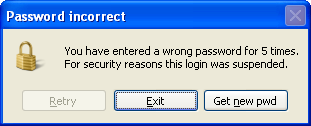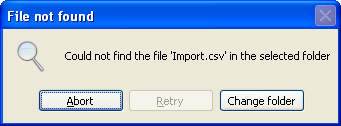This is just an update for the original article. Originally this function needed Craig Boyd’s VFPEX.FLL to be able to update the Messagebox dialog. In this new version, I’m using VFP9 BINDEVENTS function, to bind to Windows events directly.
MSGBOXEX() is a simple function that allows us to customize the captions of buttons of the MESSAGEBOX(), dialog window, like in the images shown below:

Sample 1:
lnOption = MsgboxEx( ; "You have entered a wrong password for 5 times." + CHR(13) + ; "For security reasons this login was suspended.", ; && main message 0, ; && default icon info "Password incorrect", ; && title bar caption "\&Retry,&Exit,Get &new pwd", ; && new button captions "41.ico") && icon file


Sample 2:
lnOption = MsgboxEx(;
"An unexpected error has occurred and the system needs to be restarted." + ;
CHR(13) + CHR(13) + "What do you want to do ?", ;
"X", ;
"MsgboxEx sample", ;
"Restart &Now,Restart &later,&Never restart")


Sample 3:
lnOption = MsgboxEx( ;
"Could not find the file 'Import.csv' in the selected folder.", ;
0, ;
"File not found", ;
"&Abort,\&Retry,Change folder", ;
"17.ico")


Function: MsgboxEx.prg
Description: Modifies the captions of messagebox buttons
Parameters:
- tcCaption - the text that appears in the dialog box.
- tnIcon - the icon sign - can be numeric, using the default messagebox() icon values or character:
- stop sign: 16 or "x"
- question mark: 32 or "?"
- exclamation point: 48 or "!"
- information: 64 or "i" - tcTitle - the text that appears in the title bar of the dialog box
- tcButtons - the captions to be used in the buttons using the comma "," delimiter
use the "&" character to determine the hotkeys to be used - eg: "option&1,option&2,option&3" - the "\" backslash can be used to show the current button disabled. - tcIconFile - (optional) the icon image file
Returns: The index number according to the option selected - eg. returns the value 3 if the 3rd button was selected.
Pros:
use the same dialog interface from the messagebox() function, allowing us to easilly customize existing dialog boxes.
almost the same structure of parameters of the original function
behaves correctly in all operating systems.
allows hotkeys (thanks to thiago takehana for reminding about this possibility)
Cons:
up to 3 buttons are allowed
size of buttons is limited to the original messagebox() buttons size, not allowing big sized buttons.
LPARAMETERS tcCaption, tnIcon, tcTitle, tcButtons, tcIconFile * msgboxex.prg * description: modifies the Captions of messagebox Buttons * Parameters: * tcCaption - the text that appears in the dialog box. * tnIcon - the Icon sign * tcTitle - the text that appears in the Title bar of the dialog box * tcButtons - the Captions to be used in the Buttons using the comma "," delimiter * use the "&" character to determine the hotkeys to be used - eg: "option&1,option&2,option&3" * use a "\" to disable the Button * tcIconFile - the Icon File to replace the default from messagebox() * returns: the index number according to the option selected - eg. returns the value 3 if the 3rd Button was selected. * sample: * =MsgBoxEx("This is a common text", "!", "Window Title", "Option 1,Option 2,Option 3") * Special thanks to: * Herman Tan - Article: 'Centering VFP MessageBox in any Form' * http://hermantan.blogspot.com/2008/07/centering-vfp-messagebox-in-any-form.html * Craig boyd - Article: 'BindEvents on Steroids' * http://www.sweetpotatosoftware.com/spsblog/2005/08/07/bindeventonsteroids.aspx LOCAL loMsgB, lnOption loMsgB = CREATEOBJECT("xmbMsgBoxEx") =INKEY(.1) lnOption = loMsgB.SendMessage(tcCaption, tnIcon, tcTitle, tcButtons, tcIconFile) loMsgB = NULL RETURN lnOption DEFINE CLASS xmbMsgBoxEx AS CUSTOM nButtonCnt = 0 cButtons = "" nbutttype = 0 cIconFile = "" hIcon = 0 PROCEDURE SendMessage LPARAMETERS tcCaption, tnIcon, tcTitle, tcButtons, tcIconFile IF VARTYPE(tntimeout) = "C" AND (PCOUNT() = 4) tcButtons = tntimeout tntimeout = 0 ENDIF PRIVATE pnButtonCnt, pcButtons, pnbutttype, pcIconFile, phIcon This.cIconFile = IIF(EMPTY(tcIconFile),"", tcIconFile) This.nButtonCnt = GETWORDCOUNT(tcButtons, ",") This.cButtons = tcButtons *!* stop 16 *!* question 32 *!* exclamation 48 *!* info 64 IF (NOT EMPTY(m.tcIconFile)) OR INLIST(TRANSFORM(tnIcon), "X", "?", "!", "I") IF VARTYPE(tnIcon) = "C" tnIcon = UPPER(tnIcon) DO CASE CASE tnIcon = "X" tnIcon = 16 CASE tnIcon = "?" tnIcon = 32 CASE tnIcon = "!" tnIcon = 48 CASE tnIcon = "I" tnIcon = 64 OTHERWISE tnIcon = 0 ENDCASE ENDIF ELSE tnIcon = 0 ENDIF * check if an Icon will be shown * if an Icon File was passed, we need to ensure that messagebox() will * show an Icon, that will be changed further. #DEFINE image_bitmap 0 #DEFINE image_Icon 1 #DEFINE lr_loadfromFile 0x0010 #DEFINE lr_defaultsize 0x0040 This.hIcon = 0 IF NOT EMPTY(This.cIconFile) AND ; (NOT (BITTEST(tnIcon, 4) OR BITTEST(tnIcon, 5) OR BITTEST(tnIcon, 6))) tnIcon = tnIcon + 16 This.hIcon = xmbLoadImage(0, FULLPATH(This.cIconFile), image_Icon,; 0,0, lr_loadfromFile + lr_defaultsize) ENDIF * this messagebox will be modified before it is shown LOCAL lnoption, lnIndex DO CASE CASE This.nButtonCnt = 1 This.nbutttype = 0 && ok CASE This.nButtonCnt = 2 This.nbutttype = 4 && yes / no CASE This.nButtonCnt = 3 This.nbutttype = 2 && abort / retry / ignore OTHERWISE ENDCASE BINDEVENT( 0, 0x06, THIS, 'WndProc' ) lnoption = MESSAGEBOX(tcCaption, tnIcon + This.nbutttype, tcTitle) UNBINDEVENTS( 0, 0x06 ) LOCAL lnOffset lnOffset = ICASE(This.nButtonCnt = 3, 2, This.nButtonCnt = 2, 5 , 0) lnIndex = lnoption - lnOffset IF This.hIcon <> 0 =xmbdeleteobject(This.hIcon) && clear Icon handle ENDIF RETURN lnIndex ENDPROC * Windows event handler procedure * MSDN WindowProc callback function * http://msdn.microsoft.com/en-us/library/windows/desktop/ms633573(v=vs.85).aspx * http://hermantan.blogspot.com/2008/07/centering-vfp-messagebox-in-any-form.html * Here we will make all the modifications in the Windows dialog PROCEDURE WndProc( th_Wnd, tn_Msg, t_wParam, t_lParam ) IF (tn_Msg == 0x06) AND (t_wParam == 0) AND (t_lParam <> 0) wParam = t_lParam #DEFINE dlg_ctrlid_Icon 0x0014 #DEFINE stm_setIcon 0x0170 #DEFINE stm_setimage 0x0172 IF NOT EMPTY(This.hIcon) * changing the dialog Icon LOCAL lhIconwindow lhIconwindow = xmbGetDlgItem(wParam, dlg_ctrlid_Icon) IF lhIconwindow <> 0 IF This.hIcon <> 0 =xmbSendMessage(lhIconwindow, stm_setIcon, This.hIcon, 0) ENDIF ENDIF ENDIF * Set tansparency IF VARTYPE(_Screen.xmbMessageboxTransp) = "N" LOCAL lnTransp lnTransp = _Screen.xmbMessageboxTransp IF lnTransp > 30 AND lnTransp < 255 && values lower than 30 generate an almost invisible dialog!!! lnTransp = MIN(INT(lnTransp), 254) =xmbSetWindowLong( wParam, -20, ; BITOR( xmbGetWindowLong( wParam, -20 ), 0x80000 )) =xmbSetLayeredWindowAttributes( wParam, 0, lnTransp, 2 ) ENDIF ENDIF * change Button attributes LOCAL N, lnOffset, lcCaption lnOffset = ICASE(This.nButtonCnt = 3, 2, This.nButtonCnt = 2, 5 , 0) LOCAL lnBtnhWnd FOR N = 1 TO This.nButtonCnt lcCaption = GETWORDNUM(This.cButtons, N, ",") + CHR(0) * disable current Button IF LEFT(lcCaption, 1) = "\" lcCaption = SUBSTR(lcCaption, 2) && get the rest of the string lnBtnhWnd = xmbGetDlgItem(wParam, lnOffset + N) =xmbEnableWindow(lnBtnhWnd, 0) ENDIF * change the Caption =xmbSetDlgItemtext(wParam, lnOffset + N, lcCaption) ENDFOR ENDIF LOCAL pOrgProc pOrgProc = xmbGetWindowLong( _VFP.hWnd, -4 ) = xmbCallWindowProc( pOrgProc, th_Wnd, tn_Msg, t_wParam, t_lParam ) ENDPROC ENDDEFINE
*********************************************************************
FUNCTION xmbSetDlgItemtext(hdlg, nidDlgItem, lpString) ********************************************************************* DECLARE INTEGER SetDlgItemText IN user32 AS xmbsetDlgItemtext ; LONG hdlg,; LONG nidDlgItem,; STRING lpString RETURN xmbSetDlgItemtext(hdlg, nidDlgItem, lpString) ENDFUNC ********************************************************************* FUNCTION xmbCallNextHookEx(hhook, ncode, wParam, LParam) ********************************************************************* DECLARE LONG callnexthookex IN user32 AS xmbcallnexthookex ; LONG hhook, LONG ncode, LONG wParam, LONG LParam RETURN xmbcallnexthookex(hhook, ncode, wParam, LParam) ENDFUNC
********************************************************************* FUNCTION xmbGetDlgItem(hdlg, nidDlgItem) ********************************************************************* * hdlg in handle to the dialog box that contains the control. * nidDlgItem in specifies the identifier of the control to be retrieved * http://msdn.microsoft.com/en-us/library/ms645481(vs.85).aspx DECLARE INTEGER GetDlgItem IN user32 AS xmbgetDlgItem ; LONG hdlg,; LONG nidDlgItem RETURN xmbGetDlgItem(hdlg, nidDlgItem) ENDFUNC ********************************************************************* FUNCTION xmbEnableWindow(hWnd, fEnable) ********************************************************************* DECLARE INTEGER EnableWindow IN user32 AS xmbEnablewindow INTEGER hWnd, INTEGER fEnable RETURN xmbEnableWindow(hWnd, fEnable) ENDFUNC ********************************************************************* FUNCTION xmbSendMessage(hwindow, msg, wParam, LParam) ********************************************************************* * http://msdn.microsoft.com/en-us/library/bb760780(vs.85).aspx * http://www.news2news.com/vfp/?group=-1&function=312 DECLARE INTEGER SendMessage IN user32 AS xmbsendmessage; INTEGER hwindow, INTEGER msg,; INTEGER wParam, INTEGER LParam RETURN xmbSendMessage(hwindow, msg, wParam, LParam) ENDFUNC ********************************************************************* FUNCTION xmbLoadImage(hinst, lpszname, utype, cxdesired, cydesired, fuload) ********************************************************************* DECLARE INTEGER LoadImage IN user32 AS xmbloadimage; INTEGER hinst,; STRING lpszname,; INTEGER utype,; INTEGER cxdesired,; INTEGER cydesired,; INTEGER fuload RETURN xmbLoadImage(hinst, lpszname, uType, cxdesired, cydesired, fuload) ENDFUNC ********************************************************************* FUNCTION xmbDeleteObject(hobject) ********************************************************************* DECLARE INTEGER DeleteObject IN gdi32 AS xmbdeleteobject INTEGER hobject RETURN xmbdeleteobject(hobject) ENDFUNC ********************************************************************* FUNCTION xmbCallWindowProc(lpPrevWndFunc, nhWnd, uMsg, wParam, LParam) ********************************************************************* DECLARE LONG CallWindowProc IN User32 ; AS xmbCallWindowProc ; LONG lpPrevWndFunc, LONG nhWnd, ; LONG uMsg, LONG wParam, LONG LParam RETURN xmbCallWindowProc(lpPrevWndFunc, nhWnd, uMsg, wParam, LParam) ENDFUNC ********************************************************************* FUNCTION xmbGetWindowLong(nhWnd, nIndex) ********************************************************************* DECLARE LONG GetWindowLong IN User32 ; AS xmbGetWindowLong ; LONG nhWnd, INTEGER nIndex RETURN xmbGetWindowLong(nhWnd, nIndex) ENDFUNC ********************************************************************* FUNCTION xmbSetWindowLong(nHWnd, nIndex, nNewVal) ********************************************************************* DECLARE INTEGER SetWindowLong In Win32Api ; AS xmbSetWindowLong ; INTEGER nHWnd, INTEGER nIndex, INTEGER nNewVal RETURN xmbSetWindowLong(nHWnd, nIndex, nNewVal) ********************************************************************* FUNCTION xmbSetLayeredWindowAttributes(nHWnd, cColorKey, nOpacity, nFlags) ********************************************************************* DECLARE INTEGER SetLayeredWindowAttributes In Win32Api ; AS xmbSetLayeredWindowAttributes ; INTEGER nHWnd, STRING cColorKey, ; INTEGER nOpacity, INTEGER nFlags RETURN xmbSetLayeredWindowAttributes(nHWnd, cColorKey, nOpacity, nFlags)
History:
2009-10-19 Extended Messagebox function original version (change captions)
2009-10-23 Extended Messagebox function updated, allowing icon change and disabling buttons
2012-01-30 Updated, no need of external FLL library
2014-03-14 Updated, fix that was not showing the custom icon in some situations
